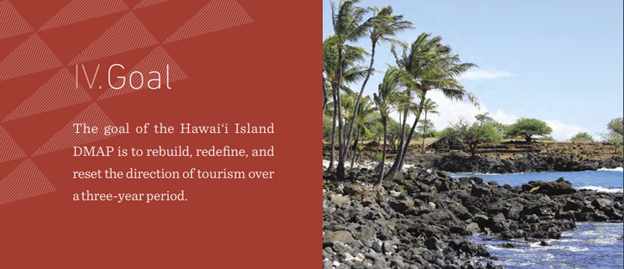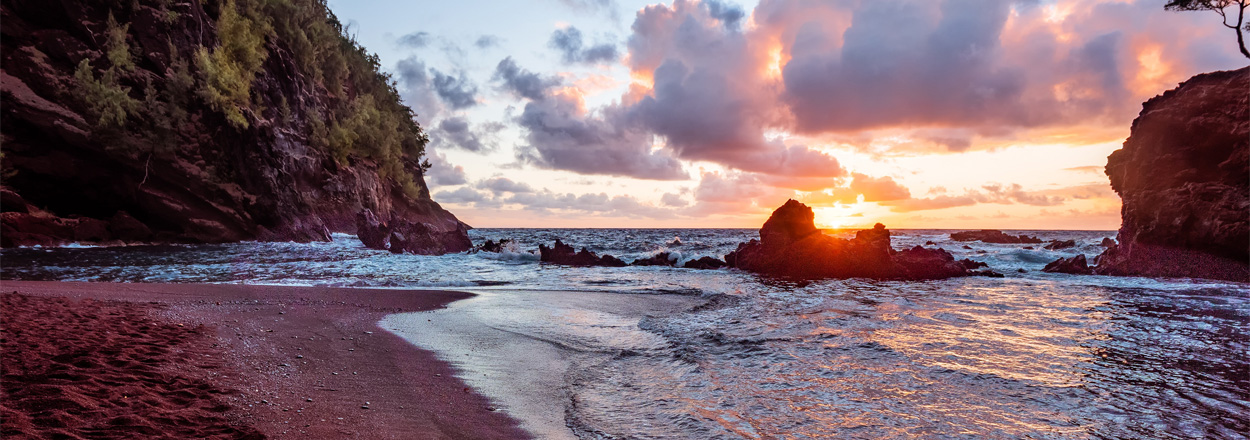Stunning coastlines, gorgeous topography and a unique and welcoming culture make Hawai’i a bucket list destination for many. So many, in fact, that in 2019, the Hawaiian Islands hosted a record high of 10.4 million visitors resulting in $17.75 billion in revenue to local businesses, $2.07 billion in taxes gained and 216,000 jobs throughout the state. The impact was massive on the region’s economy, but people sometimes fail to recognize that these record-breaking stats are also taxing on the destination and the people who live there. Simply put, Hawai’i was, and continues to, suffer the burden of overtourism a term defined by the Oxford Dictionary as, “the phenomenon whereby certain places of interest are visited by excessive numbers of tourists, causing undesirable effects for the places visited.”
This realization prompted the Hawai’i Tourism Authority (HTA), in partnership with the counties and their respective visitor bureaus, to create community-based Destination Management Action Plans (DMAPs) to, “rebuild, redefine and reset the direction of tourism over a three-year period,” in order to focus on stabilization and recovery for each island. If successful, these actionable solutions will improve residents’ quality of life while simultaneously improving the visitor experience throughout the state.

Image from HTA's Hawai'i Island Action Plan
Hawai’i Island’s nine-step DMAP
- Action A: Protect and preserve culturally significant places and hotspots.
- Action B: Develop resources and educational programs to perpetuate authentic Hawaiian culture and ‘Ōlelo Hawai‘i.
- Action C: Support and promote ‘āina-based education and practices to protect and preserve our natural resources so that residents and visitors will aloha ‘āina.
- Action D: Create opportunities for ongoing dialogue, communications and engagement between the visitor industry, government and communities to improve community-industry relations and better serve the community.
- Action E: Implement comprehensive communication and education plan that facilitates positive community-visitor relations and pono practices, including the Pono Pledge.
- Action F: Promote agritourism and partner with Hawai’i Island’s agriculture industry to support local food security.
- Action G: Invest in community-based programs that enhance the quality of life for communities.
- Action H: Advocate/create more funding sources to improve infrastructure.
- Action I: Improve enforcement of vacation rental regulations.

Image from HTA's Hawai'i Island Action Plan
DMAP Spring 2022 Progress Report
Since its launch in 2020, lots of progress has been made on the Hawai’i Island DMAP. Here’s where each goal stands as of August 15th, 2022.
Action A
Several initiatives are underway to help achieve Action A — “Protect and preserve culturally significant places and hotspots.” One primary focus includes working with KUPU and the Hawai’i State Department of Land and Natural Resources (DLNR) to create ongoing stewardship programs in addition to an Island of Hawai‘i Mālama familiarization trip for pre-qualified advisors to help educate them on future messaging, storytelling, cultural activities and more. Within local communities, the county has established two stewardship positions that will focus on conducting support and data collection within four hotspot areas — Kealakekua, Hōnaunau, Ho‘okena and Miloli‘i.
Two additional sub-actions within Action A include working with stakeholders to communicate areas that need to be protected and creating opportunities for community members to share the impact of tourism in an ongoing way.
Action B
Action B is all about embracing authentic Hawaiian culture, as a reminder, here’s the goal — “Develop resources and educational programs to perpetuate authentic Hawaiian culture and ‘Ōlelo Hawai‘i (Hawaiian language).” So far, lots is being done to bring Action B to life. The Island of Hawaii Visitor Bureau (IHVB), the Native Hawaiian Hospitality Association (NaHHA) and the University of Hawai’i’s School of Travel Industry Management (TIM) are working in tandem to do several things — identify and assess providers and learning tools, support cultural education and training programs (and to recognize businesses who complete said training), to promote HTA’s Ma‘ema‘e Toolkit, and to increase opportunities for locals and cultural practitioners to interact with travelers.
Other things to lot forward to upon the completion of Action B are a tour guide certification program, continued support of already existing programs and projects in the area and the integration of the Hawaiian language into the workforce and adult training programs.
Action C
Action C has a strong focus on protecting the vast landscapes that make Hawai’i so special. Defined as “supporting and promoting ‘āina-based (land-based) education and practices to protect and preserve our natural resources so that residents and visitors will aloha ‘āina”, the IHVB kicked off this initiative by partnering with new and existing land-based groups focused on protecting some of the region’s most iconic sites, cultural practices and people. As this goal builds momentum, the islands aim to create a certification program for workers associated with natural and cultural resources as well as those involved in land stewardship to help build a new curriculum focused on Native Hawaiian knowledge, culture, place and management based on pono practices. The state will go on to support interested groups as they serve as educators, trainers and cultural ambassadors to share cultural knowledge with travelers, tour operators and business owners.
In addition to education, this goal is largely focused on taking action to protect Hawai’i’s waters, beaches and popular hiking trails with strategies for congestion management, carrying capacities and policies to deal with what DMAP is calling ‘rouge’ visitors.
Action D
Communication is key for this phase, Action D aims to “create opportunities for ongoing dialogue, communications, and engagement between the visitor industry, government and communities to improve community-industry relations and better serve the community.” At the heart of Action D is an ongoing campaign focused on resident education and awareness using both traditional and social media efforts. Additionally, the state is working to create opportunities for travelers, local government and community stakeholders to connect on a regular basis to discuss issues within local communities and that visitors may face in addition to ensuring that tourism is supporting Hawai’i’s sustainability initiatives.
Lastly, Action D also stresses opportunities for collaboration with the HTA and its outreach efforts within the community to inform the industry and the community of its mission and resources.
Action E
“I pledge to be pono (righteous) on the island of Hawai’i. I will mindfully seek wonder, but not wander where I do not belong. I will not defy death for breathtaking photos, trespass or venture beyond safety.” This is the Pono Pledge and it plays an integral role in Action E —" Implement comprehensive communication and education plan that facilitates positive community-visitor relations and pono practices, including the Pono Pledge.”
One of the first steps in this phase of Hawai’i’s DMAP is getting the word out about the Pono Pledge by increasing messaging efforts to help shift visitor and resident mindsets as they explore Hawai’i Island. With awareness comes knowledge and the state aims to provide visitors with easy access to messaging and educational materials such as in-flight entertainment, radio announcements, podcasts and required visitor orientation. The Pono Pledge will also be implemented throughout the islands in places like apps, QR codes, near the airport baggage claim and within booking information.
Action F
According to Feeding America, one in 10 people is facing hunger in Hawai’i. To combat this startling stat, Action F is working to create, support and promote agritourism initiatives that will connect regional producers with visitors in addition to encouraging travelers to purchase local produce, products and goods. Eventually, HTA hopes to help local producers sell their goods online by improving Hawai’i’s online infrastructure, transportation of goods, marketing and fulfillment of orders.
Action G
The seventh piece of Hawai’i’s DMAP puzzle brings special attention to the region’s Native people and year-round residents with a goal to invest in community-based programs that enhance their quality of life. To do this, HTA will support community-led efforts and will offer opportunities to strengthen the island’s product offerings. Additionally, the organization will aim to encourage tourism that is reflective of Hawai’i Island and its communities.
Action H
While work on Action H hasn’t begun yet, it promises to be one of the most exciting initiatives for the islands with the goal of advocating and creating more funding to improve infrastructure. Action H will address community and industry needs through cohesive infrastructure needs for both motorized and non-motorized forms of transportation (hello, wider bike lanes and smoother roads).
Action I
Last but not least, Action I will tackle rising concerns surrounding housing shortages and vacation rental woes by confirming the existing number of vacation rentals and gauging the region’s ability to host current and new rentals. Since rules surrounding vacation rentals are limited, this action will also explore ways for Hawai’i to improve enforcement.
Want to learn more? Read the full Spring 2022 updates from the Hawai’i Island Destination Management Action Plan progress report.






comments